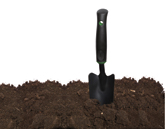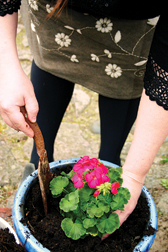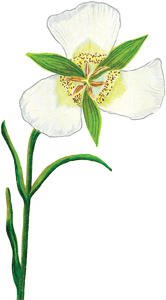Gimme the Dirt!
04 Mar 2010
The secret to a great garden lies just beneath your feet.
 Hardy blooms start with healthy soil, and spring is the ideal time to get your dirt in tip-top shape.
“The bottom line is that soil is a living system, providing the fundamental support for all terrestrial life,” says Dr. Jean Reeder, retired soil scientist with the USDA Agriculture Research Service. “We need to feed and nurture our soils so they can feed and nurture the plants, animals and us.”
But appearances can be deceiving, because not everything in dirt is soil. Healthy soil is 50 percent solids, like humus, sand, clay and stones; the other 50 percent is pore space for the air and water that roots need to grow.
Yards in newly developed areas don’t often have this roomy soil, because home construction churns the ground and packs it tight, leaving little pore space. In the clay that pervades most Front Range yards, this compaction smothers roots and makes soils drain poorly.
Improving soil is the long-term solution to compacted clay, but every garden has different needs. “It makes sense to first decide what you want to grow, and then make a decision about amending the soil,” says Marcia Tatroe, author of Cutting-Edge Gardening in the Intermountain West. “You make a decision about where the best place for a vegetable garden is, then amend that area for that purpose.” Other areas can be specifically amended for perennials, annuals, natives, succulents or whatever plants you intend to grow.
“That’s a whole different philosophy than we’ve all been taught, but I can’t overemphasize this enough. Work each area separately, and you end up having more choices” for different gardens in the same yard, Tatroe says. “Within my yard I have a sandy loam, a straight silt and clay—three radically different soils all on one-eighth of an acre.”
Before amending soil, get a soil test to determine what type of soil you have. Then determine if your soil is good as-is for the plants you want to grow, or if it needs amending. Soil tests are available from the Soil, Water and Plant Testing Laboratory at Colorado State University in Fort Collins. Other labs also offer soil tests; visit the Colorado State University Extension website for a list.
Hardy blooms start with healthy soil, and spring is the ideal time to get your dirt in tip-top shape.
“The bottom line is that soil is a living system, providing the fundamental support for all terrestrial life,” says Dr. Jean Reeder, retired soil scientist with the USDA Agriculture Research Service. “We need to feed and nurture our soils so they can feed and nurture the plants, animals and us.”
But appearances can be deceiving, because not everything in dirt is soil. Healthy soil is 50 percent solids, like humus, sand, clay and stones; the other 50 percent is pore space for the air and water that roots need to grow.
Yards in newly developed areas don’t often have this roomy soil, because home construction churns the ground and packs it tight, leaving little pore space. In the clay that pervades most Front Range yards, this compaction smothers roots and makes soils drain poorly.
Improving soil is the long-term solution to compacted clay, but every garden has different needs. “It makes sense to first decide what you want to grow, and then make a decision about amending the soil,” says Marcia Tatroe, author of Cutting-Edge Gardening in the Intermountain West. “You make a decision about where the best place for a vegetable garden is, then amend that area for that purpose.” Other areas can be specifically amended for perennials, annuals, natives, succulents or whatever plants you intend to grow.
“That’s a whole different philosophy than we’ve all been taught, but I can’t overemphasize this enough. Work each area separately, and you end up having more choices” for different gardens in the same yard, Tatroe says. “Within my yard I have a sandy loam, a straight silt and clay—three radically different soils all on one-eighth of an acre.”
Before amending soil, get a soil test to determine what type of soil you have. Then determine if your soil is good as-is for the plants you want to grow, or if it needs amending. Soil tests are available from the Soil, Water and Plant Testing Laboratory at Colorado State University in Fort Collins. Other labs also offer soil tests; visit the Colorado State University Extension website for a list.
Different Strokes for Different Plants
Xeric gardens need good drainage, which means they don’t like the choco d topsoil mixed with compost (30 percent compost; 70 percent topsoil) and till it in as deeply as you can. This gives you gritty soil with good drainage.
Fast-growing, water-loving crops like vegetables and annuals need richer soil. For these plants, choose organic matter to amend the soil.
Which amendment you pick is a personal choice, Reeder says, but examine your soil test closely before amending. “You need to know how salty your soil already is,” she says. “If you’re going to buy a topsoil or animal-based compost (like manure), test your soil first. These amendments can be really salty, putting your soil over the top and poisoning your plants. The beauty of plant-based compost is that it’s low in salt. That stuff is pure gold.”
Don’t fix your soil in one large load, though. You risk building up natural soluble salts from over-amending, which can burn plant roots. Instead, add amendments slowly over a period of time. The rule of thumb is to wait until the ground is soft and dry enough to work, then spread 1 inch of organic matter across the top and till it in 6 to 8 inches deep.
d topsoil mixed with compost (30 percent compost; 70 percent topsoil) and till it in as deeply as you can. This gives you gritty soil with good drainage.
Fast-growing, water-loving crops like vegetables and annuals need richer soil. For these plants, choose organic matter to amend the soil.
Which amendment you pick is a personal choice, Reeder says, but examine your soil test closely before amending. “You need to know how salty your soil already is,” she says. “If you’re going to buy a topsoil or animal-based compost (like manure), test your soil first. These amendments can be really salty, putting your soil over the top and poisoning your plants. The beauty of plant-based compost is that it’s low in salt. That stuff is pure gold.”
Don’t fix your soil in one large load, though. You risk building up natural soluble salts from over-amending, which can burn plant roots. Instead, add amendments slowly over a period of time. The rule of thumb is to wait until the ground is soft and dry enough to work, then spread 1 inch of organic matter across the top and till it in 6 to 8 inches deep.












